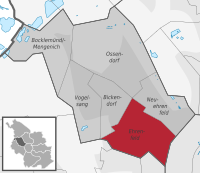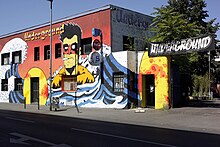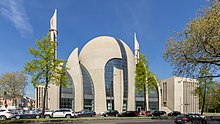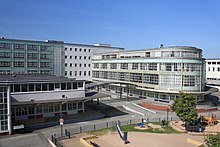Ehrenfeld (Cologne)
|
Ehrenfeld district 401 of Cologne |
|
|---|---|
| Coordinates | 50 ° 56 '47 " N , 6 ° 55' 6" E |
| surface | 3,721.5 km² |
| Residents | 37,856 (Dec. 31, 2017) |
| Population density | 10,172 inhabitants / km² |
| Incorporation | Apr 1, 1888 |
| Postcodes | 50823, 50825, 50827 |
| prefix | 0221 |
| Borough | Ehrenfeld (4) |
| Transport links | |
| Federal road |
|
| Railway lines | RE 1 RE 8 RE 9 RB 27 RB 38 S 12 S 13 S 19 |
| Light rail lines | 3 4th 5 13 |
| Bus routes | 140 141 142 143 |
| Source: 2017 residents . (PDF) Cologne district information | |
Ehrenfeld ( kölsch : Ihrfeld ) is a district within Cologne's 4th district of the same name . The district in the west of Cologne has been part of the city of Cologne since 1888. The cityscape is characterized today by monuments and town houses from the Wilhelminian era , industrial monuments, apartment buildings from the 1950s and 1960s that fill gaps in war construction, as well as the residential tower of the Hercules high-rise from the 1970s.
The former working class and industrial district today has a high proportion of migrants from all parts of the world. The business world is correspondingly colorful, with mainly Turkish and Italian shops and businesses, but also with many other companies owned by owners from the Middle and Far East and Africa. Ehrenfeld has a very lively cultural scene and is becoming increasingly popular as a residential area - rising rents and a growing number of theaters, restaurants and trendy bars are evidence of this.
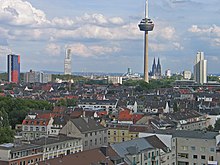
location
The Ehrenfeld district borders on Neustadt-Nord in the east, Lindenthal and Braunsfeld in the south, Müngersdorf and Bickendorf in the west and Neuehrenfeld in the north .
history

Ehrenfeld owes its creation to Cologne's advance westward, in front of the city gates. The area was already inhabited in the first to third century AD, as the discovery of a Roman country villa near today's Mechternkirche in 1996 shows. According to legend, Saint Gereon was also killed here because of his Christian faith - the name Mechtern goes back to the dialect of the Latin ad martyres sanctos (to the holy martyrs).
Until the middle of the 19th century, the area of today's Ehrenfeld had been settled and used for agriculture. In 1840 there were only three groups of houses with the Mechtern, Subbelrath and Ziegelfeld estates, which were predominantly church-owned, and were inhabited by 32 people. A brick kiln was also operated at the Ziegelfeld . The idea of founding a suburb at this point is attributed to the Cologne book printer and antiquarian Franz Anton Kreuter. He recognized the space required for commercial space and inexpensive living space due to industrialization and population growth, which could not be satisfied within Cologne and convinced politicians and investors to build a suburb. In 1845 a decision was made to build the place under the name Ehrenfeld . The name is explained by the geographical location of the area around Cologne: You left the city wall through the Ehrentor (Ehrenportz) and went west over Ehrenstrasse to get to Ehrenstrasseer Feld . As early as the spring of 1845, the first residential buildings were built on Venloer Strasse , Subbelrather Strasse and the connecting streets of Körnerstrasse, Simrockstrasse and Stammstrasse, mostly as three-window houses . The oldest preserved facade of such a house can be seen today at Venloer Str. 260: The Mertens house was built in brick in 1853. A side extension was added after 1894. From 1866 to 1971 the house was owned by the Mertens family. It housed a butcher's shop, in whose rooms a flower shop can be found today.
Ehrenfeld initially belonged to the mayor's office in Müngersdorf in the Cologne district. In 1867 Ehrenfeld became an independent municipality with over 4,000 inhabitants. In 1875 the Ehrenfelders proudly took note of their increase in rank to the “state of the cities”. However, the town charter did not follow until 1879. The Ehrenfeld coat of arms formed a comb wheel on a blue and gold background. When it became a town, Ehrenfeld left the mayor's office in Müngersdorf and was raised to its own mayor's office .
industrialization
In the year Ehrenfeld was founded, Phillip Hoffmann's wallpaper factory began operations in Phillipstrasse, which was later named after him. This was followed by the settlement of numerous companies, mainly from the fields of metal processing , chemistry , glass production and later also electrical engineering , including big company names such as Leyendecker (lead products), Herbrand (wagon factory) , Herbig (colors, later Herbol) or Helios (electrical engineering). The foundations for some of the companies and developments that are still known today were laid in Ehrenfeld during this industrial pioneering period: Helios AG , founded in 1882 for electrical light and telegraph system construction, created several milestones in AC technology . The automobile manufacturer and Audi founder August Horch developed his first automobiles in his company Horch (A. Horch & Cie.) At the current location of the Sparkasse KölnBonn on Venloer Strasse in 1899 . The perfumery factory Ferdinand Muelhens ( 4711 ) was located at Vogelsanger Straße 100 from 1874. Today the basic structures of the large foundry hall of Ostermann & Co can still be seen, which has been completely refurbished since 2014 and given a new use. On the Grüner Weg 2–4 site (now partially used by Aldi), it manufactured what was then the largest ship propeller in the world until its liquidation in 1992. On August 28, 1897 , Cornelius Stüssgen opened his first grocery store at Venloer Straße 466 .
As the population and industry grew, so did the need for public buildings and facilities. In 1863, Ehrenfeld's first school building was erected as a Catholic elementary school in Platenstrasse. At times it served as a vocational school and school for people with learning disabilities; today it is a municipal dormitory. Public institutions such as the post office and train station followed. In 1875 there were already 40 factories in Ehrenfeld - by 1886 this number had increased to 52.
During the heyday of industrialization, the Ehrenfeld city council stated : “From small beginnings, a beautiful, flourishing city of 15,000 inhabitants has emerged in a short period of less than 30 years. Its inhabitants are characterized by hard work, efficiency and community spirit, and their industry far exceeds that Borders of our fatherland is famous. "
In 1880 the Ehrenfeld town hall was built by Vincenz Statz on Venloer Straße . It was considered the most architecturally significant secular work of neo-Gothic in Cologne's suburbs. The first and only mayor of the city of Ehrenfeld was Hugo Jesse between 1880 and 1888 . In 1888 Ehrenfeld was incorporated as a district of Cologne.
Even today, parts of the Ehrenfeld townscape are shaped by buildings with industrial cultural significance. Some of the complexes, which are often listed and in some cases architecturally demanding, have been converted and rededicated, for example as event rooms, business parks, clubs or living space.
Second World War
The Second World War , which began in 1939, ended in Ehrenfeld on March 6, 1945 with the arrival of the Americans on Venloer Strasse. Like all of Cologne, Ehrenfeld, which had been the target of Allied air strikes 55 times, was hit hard and suffered severe damage. The town hall was damaged in a bombing raid on June 17, 1943 and demolished after the war.
The persecution of Jews under National Socialism led to the destruction of the Ehrenfeld synagogue on Körnerstrasse, built in 1927 based on a design by the architect Robert Stern , during the pogroms on the occasion of the so-called Reichspogromnacht . Until then, it served as a prayer house for 2000 members of the Jewish community in Ehrenfeld. Stumbling blocks by the artist Gunter Demnig in the streets of Ehrenfeld are reminiscent of the deportation of Ehrenfeld citizens, mostly Jews, in front of whose former houses they are embedded in the ground.
Members of the Ehrenfeld group of Edelweiss Pirates , a resistance group against the National Socialists active in Cologne in the summer and autumn of 1944 , were publicly executed by the Gestapo on November 10, 1944 in Hüttenstrasse without a court judgment. This section of the road is named after one of them, Bartholomäus Schink . After the war, a political and historical dispute about the group's membership in the resistance developed, which has only been largely resolved in recent years: A plaque in nearby Schönsteinstrasse commemorates the execution of Russian and Polish slave laborers and the resistance fighters of the Ehrenfeld group:
- Here on October 25, 1944, eleven citizens of Poland and the USSR who had been deported to Germany by the Nazi regime and on November 10, 1944 thirteen Germans - among them young Edelweiss pirates from Ehrenfeld and other fighters against war and terror - were made public by the Gestapo without a court judgment and SS hanged.
post war period
In the phase of the economic miracle and reconstruction, Ehrenfeld also prospered as an industrial location and working-class district. The industrial reconstruction accelerated a change that was already apparent before the war: The developing heavy industry needed space that the densely populated Ehrenfeld could no longer offer and preferred the open surrounding area. Small and medium-sized companies, for example from toolmaking , mechanical engineering or the food industry , stayed or settled, as did Wilhelm Monke. New master workshops for instrument making. There were also administrations as well as trading and service companies. In 1957 the entrepreneur Herbert Eklöh opened in the former production halls of the Helios AG (today known as Rheinlandhalle ) on 2000 m² Europe's first supermarket Eklöh of the same name . The first center for physiotherapy and med. Massage, the Fridolin bath. In 1966 111 companies with more than ten employees had their headquarters in Cologne-Ehrenfeld - this corresponded to about one sixth of the Cologne companies at that time.
The city quarter also changed structurally: As a bypass road tangential to Ehrenfeld, the now six-lane Inner Canal Road along the inner green belt was completed in 1952. Numerous vacant lots caused by the war were filled in the 1950s with residential houses in a no-frills, simple and inexpensive architectural style. Many buildings, which from today's point of view appear to be worth seeing, were demolished, often because rebuilding seemed too costly.
With the new prosperity of the early years, restaurants, cinemas and shops also came to Ehrenfeld, especially around Venloer Straße. The Ehrenfeld Carnival, with its own clubs, a children's triumvirate and the Ehrenfeld Tuesday parade developed as a separate contribution to the Cologne Carnival. A labor shortage made the influx of guest workers from Turkey and other mostly southern European countries necessary. Many of them settled permanently in Ehrenfeld and later founded their own shops, mosques and tea rooms.
Structural change
From the 1970s to the present day, Ehrenfeld's economic and social structure changed. More and more companies closed their doors - partly after economic difficulties, partly because changes and enlargements were no longer possible at the now densely populated and built-up location. As a result of the associated reduction in jobs, unemployment rose in Ehrenfeld - at the same time, the purchasing power of many residents steadily fell. As a result, a number of traders, restaurateurs and service providers left the district. Their businesses were taken over by junk shops , more or less seedy pubs or gambling halls , and later also simple internet cafés and call shops. With unemployment, crime in the quarter also increased: the working-class part of the city was also threatened with optical neglect in many places, because the numerous old buildings in particular were often threatened by decay because overdue renovations were not carried out. However, by the 1990s at the latest, low rents for residential and commercial space also attracted students and cultural workers. The latter in particular converted idle industrial buildings into studios , theaters or clubs such as "Ruine", " Underground ", " Live Music Hall ", " Loft " or "Herbrands". At the same time - often right next to takeaways - trendy bars and sophisticated restaurants emerged. There was also an art house cinema soon. Entrepreneurs and service providers followed with new business ideas. House owners are also increasingly investing in the renovation of ailing old buildings, so that entire streets are now showing colorful Wilhelminian style facades again. Today there is a coexistence in residents, architecture, shops and businesses between cheap living space and junk shops on the one hand and emerging, innovative businesses, chic living in renovated old buildings and cultural attractions on the other. The social welfare density and the unemployment rate at the beginning of 2005 were only slightly above the Cologne average. The proportion of residents with a migration background in Ehrenfeld was 35.4% as of December 31, 2017. The proportion of foreigners in 2015 was 20.0%.
Buildings and Architecture
The oldest houses in Ehrenfeld are three-window houses . The buildings were built narrow because, according to the Prussian building code, houses with a width of up to 20 feet (about 6.28 meters) were exempt from tax. They were often extended to the rear with additions. Often there were utility rooms, shops, workshops, and later offices, practices or even garages on the ground floor or in the basement . In between, wealthy entrepreneurs bought villas and town houses. The owner of the Lieck und Plümacher foundry, Xavier Liek, had a historicist half-villa built at Körnerstraße 98 in 1877 . The figures of Hephaestus / Hephaist and Mercury are in the niches on the side ; the god of blacksmiths and the god of merchants symbolize the occupation of the first house owner.
The public Neptunbad at Neptunplatz was put into operation in 1912 and was the first modern bathing establishment to open in the Cologne suburbs. The town building inspector Johannes Baptist Kleefisch was responsible for the construction . The entire interior was designed in Art Nouveau style; the statue of the young "Neptune" adorned the swimming pool. The bathing establishment was closed in 1994 and has been reopened since 2002 as the “Health Club & Spa”, which in terms of interior design ties in with the old traditions.
The former "Ehrenfelder Hof" and "Haus der Casinogesellschaft" on Venloer Straße have been owned by the Scholzen family since 1907, who run a traditional restaurant with their own distillery in the "Haus Scholzen". From 1872 to 1876 the services of the Evangelical Congregation took place here.
A bunker was built next to the former synagogue on Körnerstrasse in 1942/43 , which served as emergency accommodation for people looking for accommodation until 1955 after the end of the war . The building was last repaired in 1983/84. For a while, cultural events of the “Gestaltwechsel” initiative took place here, but this was discontinued for fire protection reasons. Since then, the bunker has served as a warehouse for the fire brigade and disaster control. It has been a listed building since 1995. Efforts are being made to reopen the bunker for cultural events.
Ehrenfeld is dominated by the 31-storey Hercules high-rise built in 1973 by the architect Peter Neufert . The residential tower was named after the neighboring Herkulesstraße and marks a traffic junction in Cologne with the beginning of the city motorway and the inner channel street. Its facade is particularly striking: it is clad with orange, blue and red enameled metal sheets, which form large color complexes that span the edges. The windows are set off in silver, varied three times and seem to be arranged in no fixed order, creating the impression of a mosaic. The colorful façade, which was renovated in 2005, gave the building the popular nickname “Parrot Tower” or “Villa Kunterbunt”.
Central mosque
On November 7th, 2009, with the laying of the foundation stone, construction work began on the new Cologne Central Mosque on the premises of the Turkish-Islamic Union of the Institute for Religion (DİTİB) on Venloer Straße / corner of Innere Kanalstraße. Cologne's first representative mosque was opened on September 29, 2018 as an imposing dome building with two minarets based on a design by Gottfried and Paul Böhm . The construction was particularly controversial in the planning phase - the citizens 'movement pro Cologne, classified as right-wing populist to right-wing extremist, together with a citizens' initiative , called for resistance to a mosque of this size . Ralph Giordano's rejection brought the planned mosque construction into the headlines nationwide. Since the start of construction, the on-site disputes on the street have significantly decreased.
Churches
The oldest existing church in Ehrenfeld is the market chapel of St. Mary's Assumption on the Geißelmarkt. The chapel was donated by Johann and Cäcillie Wahlen for the service of the Ehrenfeld Catholics and designed by Vincenz Statz in 1860. The sculptures attached to the gable depict Saint Anthony and John the Baptist . In 1944 the chapel was destroyed in a bombing raid, rebuilt in 1955 by Karl Band and transformed into a memorial to the victims of the Second World War. In 1988 the portal relief was reconstructed.
The Catholic Church of St. Mechtern has several previous buildings . According to legend, it is located at the place where the Thebaic Legion was executed. Hence its name, an abbreviation of “ad martyres sanctos”. In the Middle Ages, the church of St. Bartolomew, parish church for the scattered courtyards and small villages around, was located here on the courtyard. This church was popularly called St. Mechtern at the latest in the 18th century, as evidenced by a letter from the pastor from this time. This church was closed in the course of secularization and then demolished. A church was not built here again until 1909, now in the neo-Romanesque style. This time it was not given the old name St. Bartolomäus, but the popular name St. Mechtern. This was almost completely destroyed in World War II. Today's church, built in 1954, is the work of the architect Rudolf Schwarz .
The Evangelical Peace Church in Rotehausstrasse was built in 1876 in the Berlin arched style according to the designs of the master builder Carl Coeper. The 41.5 meter high tower was completed in 1877. The choir mosaic from 1922 served as a warrior memorial. Between 1942 and 1944 the church was partially destroyed, rebuilt in 1949 and renamed the Friedenskirche in 1950. A restoration took place from 1975 to 1977.
Industry
Ehrenfeld's most famous industrial monument is certainly the Heliosturm on Heliosstraße. This interior lighthouse , built in 1885, is often referred to as Ehrenfeld's landmark. It has no function as a navigation mark , but belonged to Helios AG, which went out in 1930, which pioneered the field of electrical engineering and, among other things, also produced lamps for beacons. The former administration building on Venloer Straße and the company's large production hall also belong to this industrial monument. The latter served under the name "Rheinlandhalle" from 1928 for sports and entertainment events such as the Cologne six-day race , but was later also used for propaganda events of the NSDAP . Today the Helioswerke complex is used by two furniture stores, shops, a fitness club and doctors. After a reconstruction in 1996, the Heliosturm itself shines again with a permanent light, which is generated by fluorescent tubes.
The United Deutsche Metallwarenfabriken (VDM), which took over Bleiröhrenwerke Wilhelm Leyendecker & Cie in 1930 , also left a striking industrial monument to Ehrenfeld: in today's Leo-Amann-Park , behind the company's former administration building (today: Citizens' Center Ehrenfeld) is the former water tower of the Factory. It was built in the style of a tower, as one would expect in fortified or church buildings, and has battlements and corner towers. It is now called the Blue-Gold Tower after the Ehrenfeld carnival society civil guard "blue-gold" , which took care of its restoration . It has a coach house , fund room, lounge and a roof terrace.
The old cemetery
The old Ehrenfeld cemetery on Weinsbergstrasse is still recognizable today as an independent complex that does not belong to the Melaten Central Cemetery, which is adjacent to the south . This is z. B. can be seen through the different path system and the separating wall. It was created around 60 years after Melaten, after the citizens of Ehrenfeld were not allowed by the Cologne city council to bury their deceased in their cemetery for a fee.
Naturally, the Ehrenfeld cemetery cannot be compared to Melaten, neither in terms of the number of graves nor in their design, but there are also noteworthy grave monuments that reflect the sepulchral culture and history of today's Cologne district.
Culture
With the Arkadas Theater, the Cologne Artists' Theater, the TheaterHaus Köln and the Artheater, Ehrenfeld owns four independent stages. The arthouse cinema Cinenova offers 705 spectators in three halls. Numerous clubs and live stages have established themselves primarily in former factories - the best known include the former underground, the workshop, the sensor club, the live music hall and Herbrand's in the former Herbrand car-making factory . Close to the train station is the Café Goldmund, the only restaurant in Cologne that is both an antiquarian and bookcrossing station.
traffic
Rail transport
The high-speed line Cologne Hbf - Aachen Hbf runs right through Ehrenfeld . The Köln-Ehrenfeld station is a regional station on the Cologne Hbf - Aachen Hbf or Cologne Hbf - Mönchengladbach Hbf .
In rail transport the station Köln-Ehrenfeld is the following lines operated (as of December 13, 2019):
S-Bahn and local trains stop above ground at Cologne-Ehrenfeld station. At ground level, tram line 13 runs more or less across the Ehrenfeldgürtel, underground tram lines 3 and 4 stop at Venloer Straße / Gürtel underground station .
- Line 3: Thielenbruch - Holweide - Deutz station - Severinsbrücke - Neumarkt - Friesenplatz - Cologne West station - Venloer Straße - Ehrenfeld station - Ehrenfeld - Bickendorf - Bocklemünd - Mengenich - Görlinger center
Line 3 runs every 10 minutes on weekdays. There are 32 stops on the approximately 22 km long route, which is traveled at an average speed of 26 km / h, of which 11 are underground stations. At Deutz station , line 3 again meets all the railway and S-Bahn lines that also run in Ehrenfeld, and in Buchheim it meets line 13 again. Some of the line 3 only runs from / to Holweide.
- Line 4: Schlebusch - Höhenhaus - Mülheim - Deutz station - Severinsbrücke - Neumarkt - Friesenplatz - Cologne West station - Venloer Straße - Ehrenfeld station - Ehrenfeld - Bickendorf - Bocklemünd .
Line 4 also runs every ten minutes on weekdays. The route of line 4 is similarly long (22 km), with 29 stops (including 12 underground stations) an average speed of 28 km / h can be driven. At Deutz station , line 4 meets all the railway and S-Bahn lines that also run in Ehrenfeld and at Wiener Platz it meets line 13 again. In the evening, line 4 only runs from / to Bickendorf Äußere Kanalstrasse .
- Line 13 "Belt Railway" : Sülzgürtel - Cologne Belt - Lindenthal - Braunsfeld - Ehrenfeld Station - Geldernstraße / Parkgürtel - Neusser Straße / Gürtel - Riehl - Mülheim - Cologne Mülheim Train Station - Holweide
Line 13 is also served every 10 minutes on weekdays. The route of line 13 is 16.2 km long, with 22 stops (including 7 tunnel stations or elevated railway stations) an average travel speed of 29.5 km / h is achieved. At Köln-Mülheim train station , it meets the RE 1 again, at Wiener Platz it meets again with line 4 and in Buchheim again with line 3.
| Previous station | Cologne light rail | Next station | ||
|---|---|---|---|---|
|
Leyendeckerstraße ← Görlinger Center |
3 |
Körnerstraße Thielenbruch → |
||
|
Leyendeckerstraße ← Bocklemünd |
4th |
Körnerstrasse Schlebusch → |
||
|
Weinsbergstrasse / Gürtel ← Sülzgürtel |
13 Belt Railway |
Subbelrather Straße / Gürtel Holweide Vischeringstraße → |
||
See also the main article on Venloer Straße / Gürtel underground station
Four light rail lines (3, 4, 5 and 13) connect Ehrenfeld with the city center and the surrounding districts. See also the main article Metro Station Rochusplatz , Metro Station Leyendeckerstraße , Metro Station Venloerstraße / belt , Körnerstraße and Piusstraße .
Road traffic
Until it was converted into a shopping and business street, Venloer Straße was one of the main arterial roads in Cologne. Today it is relieved by the nearby A 57 as well as by the Vogelsanger and Subbelrather Straße leading radially out of Cologne. As part of the Cologne ring road system, cross traffic is taken up by the Maarweg, the Äußere Kanalstraße, the Ehrenfeldgürtel and the Innere Kanalstraße.
Personalities
Persons connected to Ehrenfeld
- Norbert Burger (born November 24, 1932 in Ehrenfeld; † May 16, 2012), Mayor of Cologne from 1980 to 1999
- Heinrich Engels (born October 30, 1872 in Ehrenfeld, † December 3, 1943), Roman Catholic theologian, official in the Archdiocese of Cologne
- Pitt Krüger (born June 9, 1904, † August 26, 1989), laborer's son, teacher, socialist, pacifist, reform pedagogue, emigrant, co-founder of La Coûme and the Krüger Foundation
- Hans Mayer (born March 19, 1907; † May 19, 2001), literary scholar, critic, writer and musicologist
- Jean Pütz (born September 21, 1936), journalist and television presenter
- Josef Schnichels (born September 8, 1903, † August 7, 1964), "D'r Strühoot", legendary ice cream seller of the post-war period, mostly wearing a straw hat, committed carnivalist
- Hans Wallpott (born June 8, 1927 - † May 16, 2017 in Prüm ), committed carnivalist, founder of the Eifel Zoo, clothing manufacturer
- Klaus Dick (born February 27, 1928 in Cologne-Ehrenfeld), auxiliary bishop emeritus of the Archdiocese of Cologne
- Günter Wallraff (born October 1, 1942), journalist
- Gerhard Wilczek (born December 18, 1923, † January 19, 2003), politician, carnivalist, hobby historian and writer.
- Lutz van der Horst (born August 20, 1975), comedian
- Peter Brings (born September 8, 1964), member of the Cologne dialect band Brings
See also
literature
- Bürgerervereinigung Köln-Ehrenfeld eV (Hrsg.) / Gerhard Wilczek: För Ihrefeld - uns Veedel (commemorative publication 1979 of the Bürgerervereinigung) , Cologne 1979 (without ISBN)
- Johannes Maubach: On the trail of the old Ehrenfeld industry , Cologne 2005
- Johannes Maubach: Across Ehrenfeld - Ehrenfeld History Path (Part 1) , Cologne 2001 (without ISBN)
- Johannes Maubach: Across Ehrenfeld - Ehrenfeld History Path (Part 2) , Cologne 2002 (without ISBN)
- Bettina Mittelstraß: Ehrenfeld - A way of life , Cologne 2005, ISBN 3-462-03589-4
- Christian Schuh: Cologne's 85 districts , Cologne 2003, ISBN 3-89705-278-4
- Gerhard Wilczek: Ehrenfeld then and now , Cologne 1967
- Gerhard Wilczek: Ehrenfeld in Pictures (with Bickendorf, Ossendorf, Vogelsang and Bocklemünd-Mengenich) , Cologne 1974 (without ISBN)
Web links
Individual evidence
- ^ Historical archive of the city of Cologne: City of Ehrenfeld
- ^ Lichtstrasse in Ehrenfeld
- ↑ Ship propeller factory of Ostermann & Co in Cologne-Ehrenfeld
- ^ Supermarket In: Die Zeit from June 20, 1957
- ↑ Corina Kolbe, DER SPIEGEL: Germany's first supermarket was opened in Cologne in 1957 - DER SPIEGEL - history. Accessed July 31, 2020 .
- ^ Peter Fuchs: Chronicle of the history of the city of Cologne. Volume 2 1991, p. 295 . ISBN 978-3-7743-0261-7 .
- ↑ Inhabitants by type of migration background - data source: City of Cologne - offenedaten-koeln.de
- ↑ historical directory of architects
- ↑ Bernd Imgrund: Haus Scholzen - hospitality and "Kölscher Grappa." In: 111 Cologne pubs that you have to know. Emons 2012, ISBN 978-3-89705-838-5 ; Pp. 104-105
- ↑ Werner Schäfke (Ed.): Das neue Köln 1945–1995 1995 ISBN 3-927396-62-1 , p. 199
- ↑ Modern dome building with two minarets. Kölner Stadtanzeiger from September 26, 2006
- ↑ Giordano attacks Islamists again. Kölner Stadtanzeiger from June 1st, 2007 ( page no longer available , search in web archives ) Info: The link was automatically marked as defective. Please check the link according to the instructions and then remove this notice.
- ↑ Josef Abt, Wolfgang Vomm: The Cologne cemetery Melaten. Encounter with the past and forgotten from Rhenish history and art. Greven Verlag, Cologne 1980, ISBN 3-7743-0182-4 , p. 21 ff.
- ^ Johannes Maubach, Marianne Vogt-Werling, Michael Werling , The Ehrenfeld cemetery, monuments and personalities. Cologne 2011.
- ^ "Gerhard Wilczek" In: Kölnwiki

